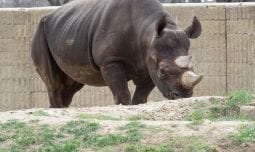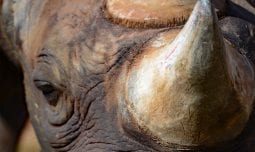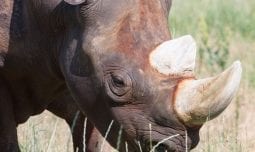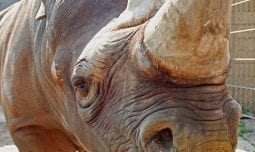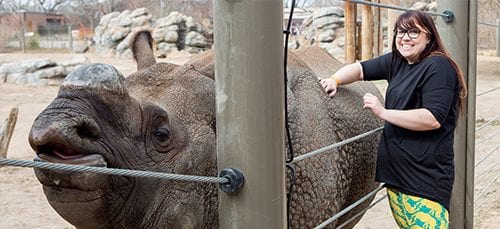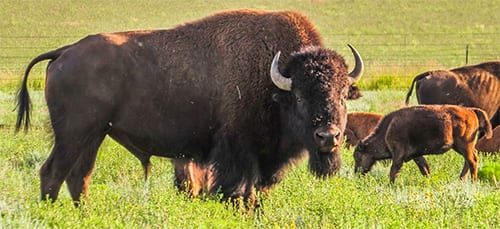Classification
Class Mammalia
Order Perissodactyla
Family Rhinocerotidae
Genus Diceros
Species bicornis
Habitat & Range
Black rhinos live in scrublands, tropical and subtropical grasslands, montane forests, savannas.
Currently they are found only in scattered pockets of Africa from the Cape to Somalia, typically in protected areas or reserves.

Black Rhinoceros
Diceros bicornis
The rhino’s horn is its most distinctive feature. Rhinos are the only animals with horns located on the nose not on the top of the head. The horns of cattle, sheep and antelopes have a bony core but rhino horn is composed entirely of keratin fibers tightly packed together. Rhino horns, which grow continuously, are used to dig up the ground to get mineral salts and also used as weapons when fighting.
Adaptations
- They have a prehensile lip which they use to grasp and strip leaves and bark from woody plants.
- Rhinos have thick but sensitive skin. They can get insect bites and even sunburn, so rhinos need access to shade and mud. Mud helps keep biting insects away and protects skin like sunscreen.
- Rhinos walk on their toes! They have three toes with a soft pad under the toes that help cushion their enormous weight.
- Rhino horns are primarily used for protection. They can break off or wear down, but will grow back over time since they are a mass of keratin (the same material as hair) perched on a roughened area of the skull.
- A rhino’s best senses are hearing and smell. They do not have very good eyesight. When the time comes for breeding, rhinos find each other by following the scent of their intended mate for miles.
Physical Description
- Black rhinos are 10.8-12.0 feet (3.3-3.6 m) long.
- They weigh 1,760-3,080 pounds (800-1,400 kg). Males are slightly larger than females.
- They stand 60-63 inches (152-161 cm) at the shoulder.
- The skin of the black rhino is dark gray or dark brown, not black.
- They have two horns on the nose. The larger anterior horn can average 1.5 feet (0.5 m) long.
- They have a large head, short neck and short, thick legs.
- They have a prehensile, pointed upper lip.
Diet
What Does It Eat?
In the wild: Black rhinos are browsers which means they feed on twigs, branches, leaves and shrubs. They also eat grasses and bark.
At the zoo: A specially formulated herbivores pellet diet, hay, browse, and produce such as lettuce, apples, and banana for enrichment and training
What Eats It?
Calves can fall prey to lions and hyenas. Although it is illegal, humans continue to hunt rhinos, primarily for their horn, which can be sold for a high price on the black market.
Social Organization
Black rhinos have been identified as solitary animals for many years, with the exception of mating pairs and females with calves. Males are primarily solitary and territorial, but recent studies have found that females and sub adults can be fairly social and share ranges.
Life Cycle
Females are mature at about five to six years; males at seven to eight years. After a gestation of 15-16 months, females give birth to a single calf weighing 75-110 pounds (35-50 kg), which the mother raises on her own. Calves are weaned at about two and a half years but may remain with the mother up for two to three years until the next calf is born. Females may stay with the mother longer than three years. Lifespan in the wild is 35-50 years, and in managed care settings extends to 45 years.
Collection Connection
Rudy, full name Rudisha, is Denver Zoo’s resident black rhino, who is located just to the right of the main entrance near the Gates Center. He was born 8/16/1993. Rudy is a very food motivated rhino, who loves browse and apples.
Fresh plant material is an essential component in black rhino diets both for their teeth and digestive health. Because of Denver’s limited growing season, Rudy gets browse flown in from Florida every week. Currently he receives 4 boxes weighing 15 kg each, 4 times per week.
Conservation Status
IUCN Status: Critically Endangered
Intensive anti-poaching efforts have allowed the black rhino population to recover from an estimated 2,000 individuals in 1993, to about 5,000. But the threat from poaching still remains great, and rhinos are slow to reproduce – having only have one calf at a time. They are also threatened by habitat loss.

Download the App!
Get the FREE Denver Zoo app today, and be a pro the next time you visit the Zoo. You’ll get access to the Zoo map, daily activities and schedules, animal facts, and more. You can even load your membership card onto the app for additional convenience. It puts everything you need for an amazing Zoo experience right into the palm of your hand!
